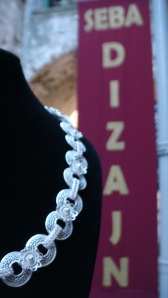 While I have been attempting some SEO for this site Doka has been carrying on with creating some new jewellery for our 2012 season. Yesterday I offered my ‘help’ with some of his work… My mission was to turn some of these (left) fine silver threads into some of these…
While I have been attempting some SEO for this site Doka has been carrying on with creating some new jewellery for our 2012 season. Yesterday I offered my ‘help’ with some of his work… My mission was to turn some of these (left) fine silver threads into some of these…

It appears so easy, especally when Doka experienced fingers are involved. I feel so clumsy but determined to get the threads rolling in the right direction. The threads that we are using are only .4mm wide, and my fingers do not yet ‘feel’ the silver and roll it like an expert. I like instant results, I like my current knitting project on 20mm needles and I so want to get this right.
 The initial roll is started with a pair of tweezers and tweeking the silver very slightly to start circular pattern. Once the beginning of the circle is formed it is then rolled between finger and thumb.
The initial roll is started with a pair of tweezers and tweeking the silver very slightly to start circular pattern. Once the beginning of the circle is formed it is then rolled between finger and thumb.
 Of course I want my rolls to be perfect and they didn’t always co-operate but after some time I ended up with about 40 of these; (they’re tiny!!!)
Of course I want my rolls to be perfect and they didn’t always co-operate but after some time I ended up with about 40 of these; (they’re tiny!!!)
They are being used to help fill in the framework that you can see above, and these pieces will become part of a new bracelet. Although I am often here and able to observe the work that is involved in creating our filigree jewellery it was a great for me to be more involved and gain even more appreciation of all the work that goes into each of our completed pieces of jewellery. The bracelet will be made up of 6 of the rectangular pieces that you can see above and will be ready to load onto the website sales section shortly.













